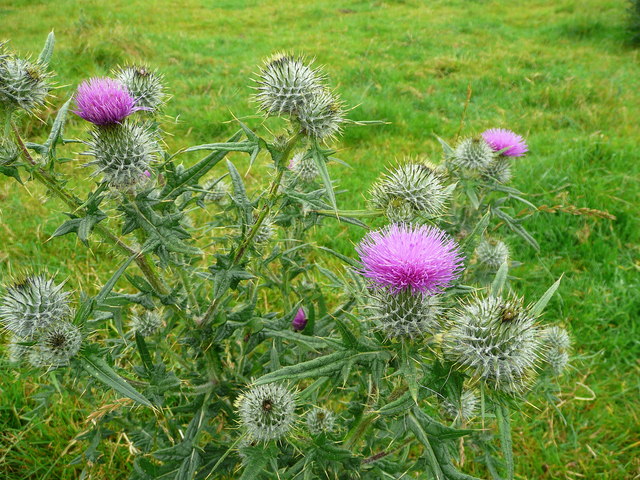Cirsium vulgare
Description
- Habitat: Thrives in disturbed soils; prefers rich, moist conditions.
- Growth: Erect, branching biennial, 2-6 feet tall. Forms rosettes in the first year, flowers in the second.
- Flowers: Pink-magenta, gumdrop-shaped, spiny, June-September.
- Stems: Up to 6 feet, spiny, winged from leaf bases.
- Leaves: Deeply lobed, rough, and hairy with sharp spines.
- Roots: Short taproot with spreading lateral roots
- Similar: Wavy Leaf Thistle, Scotch Thistle, Canada Thistle – distinguished by winged stems
Introduction and spread
- Origin: Cirsium vulgare is native to Europe, western Asia, and northern Africa. It is thought to have been introduced to the eastern United States during colonial times and the western United States in the late 1800s.
- Life Cycle: Biennial, with flowering and seed set in the second year. Seeds are short-lived on the surface but can persist for years if buried.
- Germination: Occurs in fall and spring; basal rosettes form and can grow up to 3 feet wide.
- Reproduction: Spreads only by seeds, producing 100-300 seeds per flower head. Seeds remain viable for up to 3+ years if buried deeply.
- Spread: Seeds disperse via wind (up to 2 km), animals, vehicles, and contaminated soil.
Consequences of invasion
Ecological Consequences:
- Quickly establishes in disturbed areas, displacing native plants and reducing biodiversity.
- Forms dense thickets that are unpalatable to wildlife and livestock, lowering forage potential.
- Difficult to eradicate due to high seed production and persistent germination patterns.
Economic Consequences:
- Decreases forage value by contaminating hay.
- Limits livestock migration and reduces productivity in overgrazed pastures.
Status in the CKISS region
- Bull thistle has become widespread in the CKISS region and is currently classified as Strategic Control on the CKISS Annual Priority List.
- While it is not realistic to eradicate this species at the landscape level, this species may be treated at high priority sites (e.g. wildlife habitat, corridors of spread, adjacent to agricultural land, restoration sites, etc.) based on specific land management objectives.
- To learn more about how CKISS classifies and manages invasive species, see our Invasive Species Priority Lists page.
Integrated pest management options
Prevention
- Become PlantWise and learn about Grow Me Instead. Select alternative, non-invasive plants.
- Seed Prevention: Prevent seeding by removing and properly disposing of flowering stems. Use weed-free hay to avoid spreading seeds.
- Monitoring: Regularly inspect properties and areas where hay is stored or spread for new plants.
- Soil Management: Minimize soil disturbances and use dense seed mixes to resist invasion.
Mechanical control
- Digging: Use a shovel to remove the top couple of inches of the root, especially after the plant has bolted.
- Mowing: Cut plants close to the ground before flowering. Repeat mowing throughout the season to prevent seed production.
- Cultivation: Tilling can effectively control Bull Thistle by disrupting root systems
Chemical control
- Chemical control may be an option. Consult a professional to determine whether this option is right for you.
- Always check product labels and follow directions.
- Herbicides: Use selective broadleaf herbicides during the rosette stage or after mowing. Follow label directions carefully, especially regarding grazing restrictions.
- Application: A surfactant is recommended due to the plant’s hairy leaves. Always consult local regulations and guidelines before applying herbicides.
Cultural control
- Pasture Management: Regular cutting and good pasture management reduce Bull Thistle’s competitiveness.
- Grazing: Goats, sheep, and even horses can help manage Bull Thistle by grazing on young plants and flowers before they set seed.
- Integrated Approach: Combining prevention with mechanical, chemical, and biological methods increases success. Re-seeding and reducing disturbances are key to preventing re-invasion.
Biological control
- Caution: Biological control agents should be used carefully to avoid unintended consequences on non-target species. Always consult experts and consider local ecosystems before releasing any biological control organisms. The effectiveness of biological control can vary, and it should be part of a broader, integrated pest management strategy.
- Gall Fly: The Bull Thistle seed head gall fly (Urophora stylata) reduces seed production by forming galls in flower buds. This method helps limit spread but doesn’t eliminate the plant.
- Seed Weevil: Larinus planus, a seed weevil, can be effective in reducing seed production in large infestations.
Additional resources
Sea to Sky Invasive Species Council – Bull thistle Factsheet
Lincoln Country Noxious Weed Control Board- Bull thistle Control
Whatcom Weeds – Bull thistle Factsheet
Invasive Plant Atlas – Bull thistle profile
King County – Bull thistle profile
E-Flora BC: Electronic Atlas of the Flora of British Columbia – Cirsium vulgare








